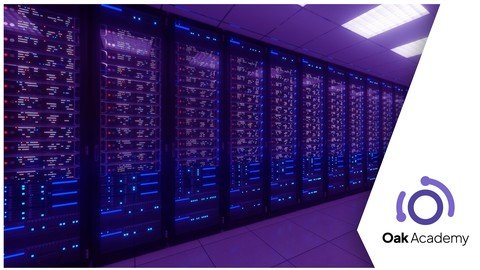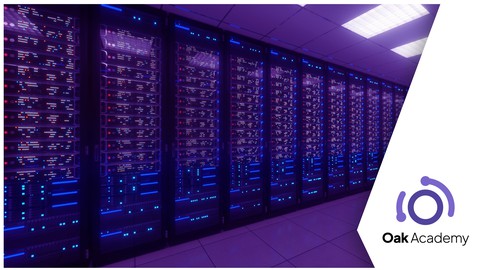
Published 4/2023
MP4 | Video: h264, 1280x720 | Audio: AAC, 44.1 KHz
Language: English | Size: 3.67 GB | Duration: 8h 51m
Server Infrastructure for IT / Technical Supporter & Server Administration and to prepare Comptia Server+ exam topics
Free Download What you'll learn
Server Form Factors
Rack Servers and Server Racks
Server Room Power Consumption
Power Management
Power Supply Unit (PSU)
Network Cabling
RAM
CPUs
Network Interface Cards (NICs)
Server Cooling Technologies
RAID Controllers
Drive Types
Local Storage vs Cloud Storage
NAS (Network Attached Storage)
SAN (Storage Area Network)
HyperConverged Infrastructure (HCI)
What is RAID
RAID 0 and RAID 1
RAID 5 and RAID 6
RAID 1+0 (RAID 10)
Server Graphical User Interface (GUI)
Server Core Installations
2 Ways to Install Server: Server Core vs GUI
Bare Metal Servers
Server Virtualization
Remote Server Administration Tools (RSAT)
Virtual Machine (VM) Cloning
Physical to Virtual (P2V)
Global Partition Table (GPT) vs. Master Boot Record (MBR)
Dynamic Disk
Linux Logical Volume Management (LVM)
ext4
New Technology File System (NTFS)
VMware File System (VMFS)
Resilient File System (ReFS)
Z File System (ZFS)
Server infrastructure consists of physical and virtual resources, along with hardware, software, network resources, to support the management of servers in IT
A server is a computer system built to share its resources, such as data, services, and programs, locally and over a network.
Requirements
Some basic networking knowledge
Watch the course videos completely, to the end and in order.
Internet Connection
Any device such as mobile phone, computer or tablet where you can watch the lesson.
Learning determination and patience.
Description
Hello there,Welcome to the "Server Infrastructure Fundamentals for Server Administrators" CourseServer Infrastructure for IT / Technical Supporter & Server Administration and to prepare Comptia Server+ exam topicsServer infrastructure consists of physical and virtual resources, along with hardware, software, network resources, to support the management of servers in an IT environment. A server is a computer system built to share its resources, such as data, services, and programs, locally and over a network.If you really want to learn Server Infrastructure and have fun while learning without getting bored, you are at the right place. With this course, you will learn many things about Server Infrastructure and itself. This course offers information from the simplest level to almost advanced. When you finish this course, there will be almost nothing you haven't heard or learned about Server Infrastructure. During the course you will learn the following topics:Server Form FactorsRack Servers and Server RacksServer Room Power ConsumptionPower ManagementNetwork CablingPower Supply Unit (PSU)RAMCPUsNetwork Interface Cards (NICs)Server Cooling TechnologiesRAID ControllersDrive TypesLocal Storage vs Cloud StorageNAS (Network Attached Storage)SAN (Storage Area Network)HyperConverged Infrastructure (HCI)What is RAIDRAID 0 and RAID 1RAID 5 and RAID 6RAID 1+0 (RAID 10)Server Graphical User Interface (GUI)Server Core Installations2 Ways to Install Server: Server Core vs GUIBare Metal ServersServer VirtualizationRemote Server Administration Tools (RSAT)Virtual Machine (VM) CloningPhysical to Virtual (P2V)Global Partition Table (GPT) vs. Master Boot Record (MBR)Dynamic DiskLinux Logical Volume Management (LVM)ext4New Technology File System (NTFS)VMware File System (VMFS)Resilient File System (ReFS)Z File System (ZFS)With my up-to-date course, you will also have the chance to keep yourself updated and have fun while learning Server Infrastructure. I am also happy to say that I will always be available to support your learning and answer your questions.What is Server Infrastructure?Server infrastructure consists of physical and virtual resources, along with hardware, software, network resources, to support the management of servers in an IT environment. A server is a computer system built to share its resources, such as data, services, and programs, locally and over a network.What are the components of server infrastructure?These components include hardware, software, networking components, an operating system (OS), and data storage, all of which are used to deliver IT services and solutions.Why is server infrastructure important?If an IT infrastructure is flexible, reliable and secure, it can help an enterprise meet its goals and provide a competitive edge in the market. Alternatively, if an IT infrastructure isn't properly implemented, businesses can face connectivity, productivity and security issues-like system disruptions and breaches.Why do you want to take this Course?Our answer is simple: The quality of teaching.Whether you work in machine learning or finance, Whether you're pursuing a career in web development or data science, Python and data science are among the essential skills you can learn.Python's simple syntax is particularly suitable for desktop, web, and business applications.The Python instructors at OAK Academy are experts in everything from software development to data analysis and are known for their practical, intimate instruction for students of all levels.Our trainers offer training quality as described above in every field, such as the Python programming language.London-based OAK Academy is an online training company. OAK Academy provides IT, Software, Design, and development training in English, Portuguese, Spanish, Turkish, and many languages on the Udemy platform, with over 2000 hours of video training courses.OAK Academy not only increases the number of training series by publishing new courses but also updates its students about all the innovations of the previously published courses.When you sign up, you will feel the expertise of OAK Academy's experienced developers. Our instructors answer questions sent by students to our instructors within 48 hours at the latest.Quality of Video and Audio ProductionAll our videos are created/produced in high-quality video and audio to provide you with the best learning experience.In this course, you will have the following:• Lifetime Access to the Course• Quick and Answer in the Q&A Easy Support• Udemy Certificate of Completion Available for Download• We offer full support by answering any questions.● A great course about Server Infrastructure.Now dive into my Now dive into my "Pandas Python Programming Language Library From Scratch A-Z™" CoursePandas mainly used for Python Data Analysis. Learn Pandas for Data Science, Machine Learning, Deep Learning using PythonSee you at the Course!
Overview
Section 1: Server Hardware Racking and Cable Solutions
Lecture 1 Server Form Factors
Lecture 2 Rack Servers and Server Racks
Lecture 3 Server Room Power Consumption
Lecture 4 Power Management
Lecture 5 Network Cabling
Section 2: Internal Server Hardware Components
Lecture 6 Power Supply Unit (PSU)
Lecture 7 RAM
Lecture 8 CPUs
Lecture 9 Network Interface Cards (NICs)
Lecture 10 Server Cooling Technologies
Lecture 11 RAID Controllers
Section 3: Evaluate and Deploy Server Storage
Lecture 12 Drive Types
Lecture 13 Local Storage vs Cloud Storage
Lecture 14 NAS (Network Attached Storage)
Lecture 15 SAN (Storage Area Network)
Lecture 16 SAN (Storage Area Network) 2
Lecture 17 HyperConverged Infrastructure (HCI)
Lecture 18 HyperConverged Infrastructure (HCI) 2
Lecture 19 What is RAID
Lecture 20 RAID 0 and RAID 1
Lecture 21 RAID 5 and RAID 6
Lecture 22 RAID 1+0 (RAID 10)
Section 4: Server Operating Systems
Lecture 23 Server Graphical User Interface (GUI)
Lecture 24 Server Core Installations
Lecture 25 2 Ways to Install Server: Server Core vs GUI
Lecture 26 Bare Metal Servers
Lecture 27 Server Virtualization
Lecture 28 Server Virtualization 2
Lecture 29 Remote Server Administration Tools (RSAT)
Lecture 30 Virtual Machine (VM) Cloning
Lecture 31 Physical to Virtual (P2V)
Lecture 32 Global Partition Table (GPT) vs. Master Boot Record (MBR)
Lecture 33 Dynamic Disk
Lecture 34 Linux Logical Volume Management (LVM)
Lecture 35 ext4
Lecture 36 New Technology File System (NTFS)
Lecture 37 VMware File System (VMFS)
Lecture 38 Resilient File System (ReFS)
Lecture 39 Z File System (ZFS)
Section 5: Extra
Lecture 40 Server Infrastructure Fundamentals for Server Administrators
Anyone who wants to learn the fundamentals of server infrastructure and anyone who are very curious about servers.
Homepage
Recommend Download Link Hight Speed | Please Say Thanks Keep Topic Live
Links are Interchangeable - Single Extraction







